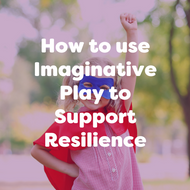How to use Imaginative Play to Support Resilience
Posted by EYR Team on 16th Mar 2021
read more
This article has been written by Jen Kinsman, EYR Industry Expert, mum of two, and youth theatre leader. In the below she shares her ideas on how imaginative play supports emotional resilience.
Have you ever felt drained, overwhelmed, or frustrated about a job and all you hear is, “you just need to be more resilient?” I’m glad to say evidence-based research can significantly change those opinions. Resilience is a skill we develop over time with the right kind of support.
The single most common factor for children who develop resilience is at least one stable and committed relationship with a supportive parent, caregiver, or other adult.
Centre of the Developing Child, Harvard University
Secure Attachment Creates Resilience
To explore resilience, we need to take a holistic overview and look at the theory of attachment. A relationship that offers protection is the scaffolding for a child to regulate their own emotions and behaviour. If our children grow in a positive environment with caring and nurturing adults, they will build the capacity to cope with life’s adversities.
Imagine baby Sam is hungry, they begin to fidget, root and quicky become distressed. Sam is beginning to panic; they need help to be fed. The parent swiftly soothes Sam gently, meeting their need by feeding them. Sam immediately is feeling good again. Over time Sam learns to trust their parents who meeting their physical and emotional needs. Sam has developed a secure attachment with their parents.
Sensitive, attuned parents who are emotionally responsive typically raise kids who are resilient and emotionally healthy, and who generally grow up to be well-adjusted and happy adults capable of cultivating mutually rewarding relationships.
P63 Dr Dan Seigel + Dr Tina Payne – The Power of Showing Up.
Psychologists use the term ‘positive stress’ when explaining everyday hurdles or life experiences children face whilst they still have the support of an adult to act as a ‘buffer’. Putting on socks, sharing toys, learning Math, or building a bridge can be tricky. The opportunity to learn how to deal with stressful situations is vital to building self-regulation skills. If learnt successfully, they begin to acknowledge their feelings and think of solutions, also known as being resilient.
I see resilience like a balloon, once blown up, it can react to the environment it is in. Once it deflates, it becomes tired and less reactive. Our job is to inject a little air into our resilience to ensure it can do its job.
Imaginative Play
The Centre of the Developing Child at Harvard University explains a supportive adult-child relationship builds a sense of self-efficacy which provides opportunities to strengthen adaptive skills and self-regulation. These are all key components of resilience that can be built through imaginative play.
Most children naturally role play: they pretend to be a teacher, parent, or superhero. Children can easily connect their environment to their role-play such as a home corner. Through role-play, children are developing and exploring problem-solving, emotional, and social skills.
Additionally, role-play can help children therapeutically prepare, rehearse, or evaluate any situation. Through the organic, creative process a child can explore situations they may have to experience such as hospital visits or first day at school. Our role is giving them the space to explore for themselves.
Here are 3 examples of imaginative play to support resilience
1. Free play such as ‘Follow My Leader’
- This can be movement-based where person A slowly moves and the rest follow. For example, they all stand in a line and person A lifts their arms, crouches down, and walks around with the tail of others following their actions. Once finished, person A taps another person on the shoulder to pass the role of the leader. You can introduce characters and themes like animals or the beach.
- Follow my leader can be based on a situation. For example, Person A is eating their dinner and the rest must replicate.
2. Guided play such as ‘Headquarters’
- Building a headquarters like a den can be made with whatever is available. One weekend, I was tired of the sheets and pillows falling so I dug out our tent. We decide our headquarters were for superheroes. The children and I become a superhero and I invent a situation such as a hailstorm or being chased by a lion to problem-solve through imaginative play. - This can easily develop into free play where the children lead on the stories. (Sometimes I gain hints on what my children are thinking or struggling with as it comes out in the play).
- The headquarters soon becomes the 3 little pig’s houses. I am told by my 2-years-old that I am the wolf, and we play out the scenes. They love running around as I chase them.
3. Sensory Play
- Using a muddy kitchen or an array of bowls, water, utensils, tea-set, glitter, foam, flour, or lentils to explore the different textures whilst adding a job role such as cook or waiter.
- Staying outside we find vegetation and bugs to investigate. We become a superhero again to help the bug or plant and save the day.
In all the examples, the children may experience distress such as being frustrated when things don’t fit into their ideas or plan. The adult who is present, can co-regulate to calm the situation down and role model how to return to the activity. The imaginative play is a rehearsal for life events, developing and practising the much-needed life skills.
My Final Thoughts
Imaginative play is a little easier with younger children as they naturally want to play. However, let us not forget our teenagers. Being able to incorporate imaginative play into their world will continue to build resilient behaviours. It is never too late to encourage some silly fun like a character-driven board game. Exercise, mindfulness, and activities that stretch the mind (executive function) all support emotional welling and resilience.
Additionally, the gift of resilience is enabling a person to be flexible and adaptable. To be able to empathise and regulate emotions supports their emotional wellbeing. Having a good understanding of oneself to make sound decisions and the ability to plan with a sense of morality are also incredibly attractive attributes. In fact, adults could do with practising their skills to model healthy behaviours and improve their resilience, so… get playing!
EYR offer a wide variety of Imaginative Play resources that can be used to support resilience as outlined in this blog. Take a look at their resources from small world play to doll play and various accessories!
Looking to learn more about how imaginative play supports children's development? Read our blog which covers why the benefits of imaginative play in the early years.


